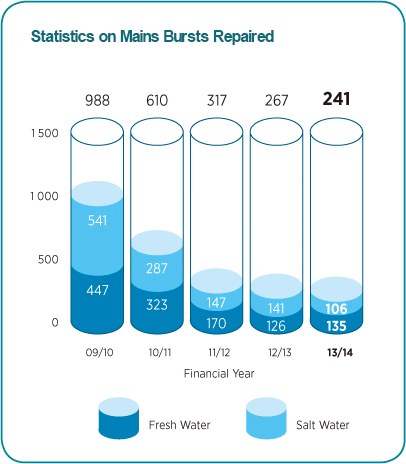- Main
- Vision, Values & Mission
- Corporate Profile
- WSD Organisation Chart
- Events in Brief
- Director’s Statement
- Key Performance Indicators
- Total Water Management Strategy
- Water Supply Management
- Water Demand Management
- Waterworks Infrastructure
- Finance and Water Charges
- Sustainable Operations
- Focusing on Customer Service
- Shaping Our Future
- Appendices and Annexes
- Download full report
(PDF 22MB)

Making Water Conservation Count
“Let’s Save 10L Water” Campaign
In support of World Water Day on March 22, 2014, the WSD launched a special campaign called “Let’s Save 10L Water”. To participate, the Hong Kong public were invited to log onto www.wsd.gov.hk/save10litres and sign a Commitment Certificate as a pledge to reduce their daily water consumption by 10 litres. Each household taking part was entitled to a free pair of flow controllers to help reduce the amount of water they use. To meet the very enthusiastic and positive response, we have increased our stock of free flow controllers to 120 000 households (far more than the original quota of 30 000 households) to be provided on a first-come first-served basis.
Promoting Water Efficient Appliances
In 2009, the Department began implementing the voluntary Water Efficiency Labelling Scheme (WELS) to encourage consumers to use appliances and equipment that conserve water. From its initial labelling of showers for bathing, the scheme has now extended to include water taps, washing machines as well as urinal equipment and flow controllers.
We are going to extend the WELS coverage to include flow controllers, beginning sometime around the second half of 2014.
Retro-fitting government buildings, schools and public housing estates with water-saving devices
The Department has completed its first phase of retrofitting new plumbing fixtures and water-saving devices in government buildings and schools. The benefits of this scheme have proven to be manifold with both reductions in water usage along with greater public awareness and appreciation of water conservation plus greater interest in water-saving devices to help reduce water consumption. In addition to this programme, we will continue to retrofit plumbing fixtures with water-saving devices and arrange for flow controllers to be installed in government buildings and schools which do not already have them, as a strategic measure to reduce water use from taps. Installation of flow controllers will also take place in selected public housing estates.
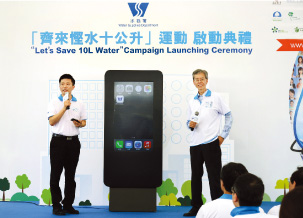
-
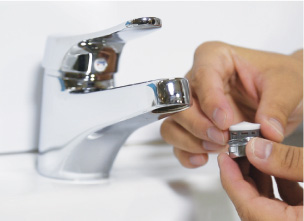
Flow controller for water tap

Raising Public Awareness
Starting from school
Since 2009, the Department has sent out invitations to primary schools across Hong Kong to join in the Water Conservation Ambassador Selection Scheme. The criteria to be selected as an Ambassador is based on individual outstanding water conservation performance vis a vis how much water is being consumed at home and the number of household members there are, etc. In July 2014, the Department held a Certificate Presentation Ceremony for Water Conservation Ambassadors at the Kowloon Bay International Trade and Exhibition Centre. This year, 3 600 students took part and 616 students were ultimately appointed as Ambassadors, a record high in terms of the number selected and the appointment ratio. This reflects a quickly rising awareness on the part of students about how to save water on a daily basis and the importance of water conservation.
In order to spark greater interest in water conservation among local youth, the WSD launched a ‘Let’s Save Water’ Cap Design Competition in 2012. All students from primary one to secondary three were eligible to take part in the competition, which was based on the ‘Save Drops for Tomorrow’ theme. Each one who entered could submit 6 photos of their cap design plus a caption or explanation of 50 words or less detailing the concept.
An award ceremony took place in May 2013. In all, 159 primary schools took part and over 10 000 design submissions were received. The themes ranged from conserving water for a better tomorrow and practical tips to conserve water to ways we can work together to achieve water conservation goals.
Public Lectures and Exhibitions
To help raise awareness and knowledge about water conservation the Advisory Committee on Water Resources and Quality of Water Supplies kicked off an event at the Hong Kong Science Museum in April 2014. Eight experts from a wide range of fields like geography, earth sciences, environment sciences, engineering, water science and the medical profession were invited to speak on various water-related topics during 4 separate sessions: “Science of water” “Water resources in China and Hong Kong,” “The challenges of water resources in China,” and “Water quality and health”. These informative sessions provided local residents with a deeper understanding of the various issues related to water and its importance in today’s society.
As a forum for outreach into the community and to help strengthen communication ties with the public that we serve, the Department holds annual water supply seminars targeted at different sectors of community, including property agents, corporation owners, hotels and academic institutions. These seminars are an effective way for us to hear about the concerns of Hong Kong with respect to water supplies. In 2013 the seminar focused on 3 key topics: “Bio-Sensing Alert Systems”, “Water Suspension Notices System” and “Consumer responsibilities on maintenance of their inside service and combating unauthorised taking of water”.
Another key public relations tool carried out by the Department is our “Save Water – Cherish the World” roving exhibitions at shopping malls and housing estates. We also deployed mobile showrooms to housing estates in Hong Kong, Kowloon and the New Territories on a regularly scheduled basis. All of these activities are focused on raising awareness in new and interesting ways about the importance of water conservation.
-
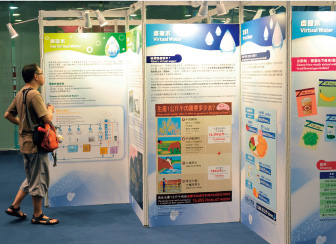
Exhibition of H2O
-
“Save Water • Cherish the World” Mobile Showroom
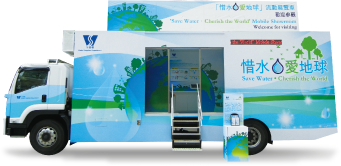
-
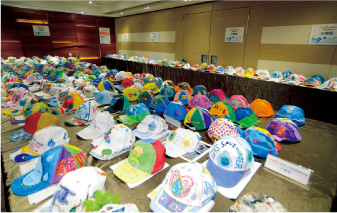
Entries of “Let’s Save Water” Cap Design Competition
-
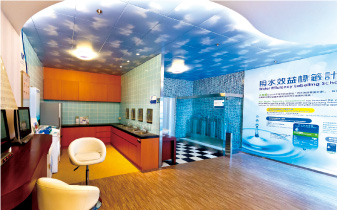
Water Saving Device Showroom in ‘Water Resources Education Centre’
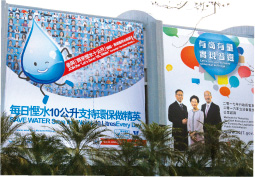
Giant outdoor banners of “Let’s Save 10L Water”
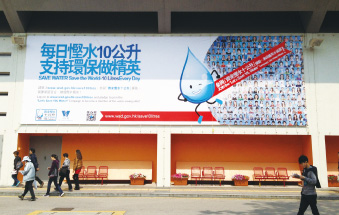
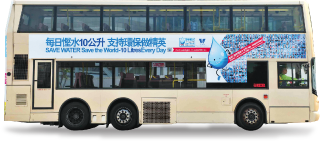
Poster regarding “Let’s Save 10L Water” on a bus
Water Efficiency Review
We have been conducting water efficiency reviews to analyse water use in selected government-managed facilities such as public swimming pools, parks and markets, and also hotel and catering operations in the private sector with a view to developing best practice guidelines. Our primary objective is to reduce overall water consumption. The review process gives us fact-based tools to craft water-saving recommendations without having to compromise the overall level of services provided to the public.
Illegal Water Use
Under the Waterworks Ordinance (WWO), drawing water without a metered instrument authorised by the Water Authority is a criminal offense, and the Department is tasked with administering the WWO and taking legal action against offenders. To help deter and combat these illegal activities, the Department’s Prosecution Unit was strengthened in 2013 in order to enhance enforcement action. In terms of the latest efforts to combat illegal water use, we have accelerated a number of education and publicity programmes on preventing the illegal taking of water not only to officers within and outside the Department but also to the public in events such as open days and school tours. We will also continue to be vigilant and monitor the consumption of water in large housing estates and rural villages to help identify leakage and unauthorised use. In 2013, the Department has prosecuted 82 cases of illegal use of water and convicted 80 of those cases. In order to help further enhance the efficiency and effectiveness of surprise inspections, we are exploring as well the use of data analytics technique to analyse water usage in order to isolate targets we suspect of unauthorised water consumption.
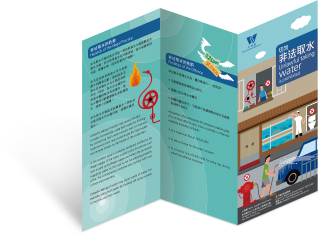
-
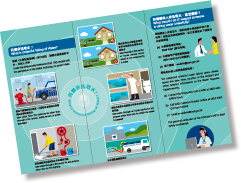
Leaflet of ‘Unlawful Taking of Water is prohibited’
Improving the Supply Network
Over the past nearly 14 years the Department has made dramatic improvements in reducing water main breaks from 2 500 in 2000/01 to just 241 in 2013/14. This has been accomplished in large part through the success of our 15-year phased in replacement and rehabilitation of nearly 3 000 km (among a total of near 8 400 km of pipelines all across Hong Kong) of water mains, resulting in significantly greater water supply reliability.
In carrying out this work, we are applying the world’s most advanced construction methods and technologies. Where applicable, we use trenchless construction, including close fit lining of existing mains, cure in-place pipes, pipe jacking and horizontal directional drilling to help reduce ground construction disruptions and limit disturbances to the public.
Outside of the urban areas, the WSD also plans to replace the undersea pipeline from Lantau and Cheng Chau islands. To do this we will employ horizontal directional drilling to help minimise the overall environmental impact as well as avoid disrupting marine and terrestrial archaelogical sites and marine traffic. We have already begun work on this project in October of 2013 and have set October 2015 as our target for completion.

| 2009/10 | 2010/11 | 2011/12 | 2012/13 | 2013/14 | |
|---|---|---|---|---|---|
| No. of Minimum Night Flow Tests | 276 | 241 | 174 | 139 | 92 |
| No. of Step Tests (or Leakage Tests) | 30 | 27 | 25 | 13 | 15 |
| No. of Sounding & Visual Inspections | 4 914 | 3 177 | 3 221 | 3 282 | 2 918 |
| No. of Leaks Detected | 2 563 | 1 846 | 2 006 | 1 432 | 1 237 |
| Estimated Quantity of Fresh Water Saved (cubic metres/day) | 93 731 | 75 299 | 79 531 | 57 128 | 47 872 |
| 2009/10 | 2010/11 | 2011/12 | 2012/13 | 2013/14 | |
|---|---|---|---|---|---|
| No. of Sounding & Visual Inspections | 155 | 304 | 532 | 516 | 488 |
| No. of Leaks Detected | 154 | 124 | 154 | 127 | 116 |
| Estimated Quantity of Sea Water Saved (cubic metres/day) | 18 204 | 29 918 | 21 719 | 35 040 | 19 881 |

Water Loss Management Initiatives
In order to manage our supply network effectively and reduce water loss, we have embarked on a replacement and rehabilitation of water mains programme to replace and rehabilitate 3 000 km of water mains and will complete in 2015. The Department will focus on the establishment of district metering areas (DMA) to carry out continuous monitoring in order to look for network anomalies and make improvements. Pressure management areas (PMA) as well help reduce network pressure in order to reduce water loss through leaks and potential bursts.
Pressure Management and Continuous Monitoring
The Department has continued its efforts to install flow meters and other pressure management equipment and instrumentation to help accurately monitor the performance and regulate water pressure within 12 of the distribution systems among Hong Kong’s 17 major supply zones. This has been undertaken in order to reduce overall water pressure, lower the number of pipe failures and effectively control overall water losses. At the remaining five zones, our investigation studies are nearly finished. As of March 2014, we have successfully installed 570 DMAs with 150 of them serving as PMAs. The eventual goal is to construct nearly 2 000 DMA/PMA zones across Hong Kong. With more and more DMA/PMA put into service that enables us to continuously monitor the daily flow, pressure as well as the minimum night flow, the need to carry out separate minimum night flow test and step test has been gradually reduced.
The Department has also undertaken new measures on a trial basis to outsource leak detection work to contractors. This has been carried out so far in the Yuen Long and Tuen Mun areas. To date, the results have been promising in helping to reduce the work load of staff in our Leak Detection Unit. Following this first trial, more recently we have also followed up by contracting out leak detection work across most of the New Territories.
To better help facilitate active leakage control, the Department has employed a number of new high tech solutions, including minimum night flow measurements, step tests, as well as routine sound and visual inspections in order to isolate and detect any leakage problems. We are also making use of the latest innovations in noise correlating equipment that runs a refined algorithm and has improved data analysis to help locate leaking points in pipes especially those with large diameters as well as non-metallic pipes. All of these upgraded technologies and equipment are helping our teams more accurately detect sources of leaks.
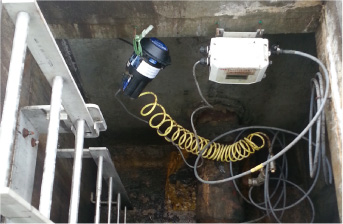
-
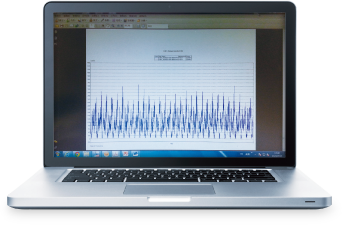
District Metering Area Chamber


